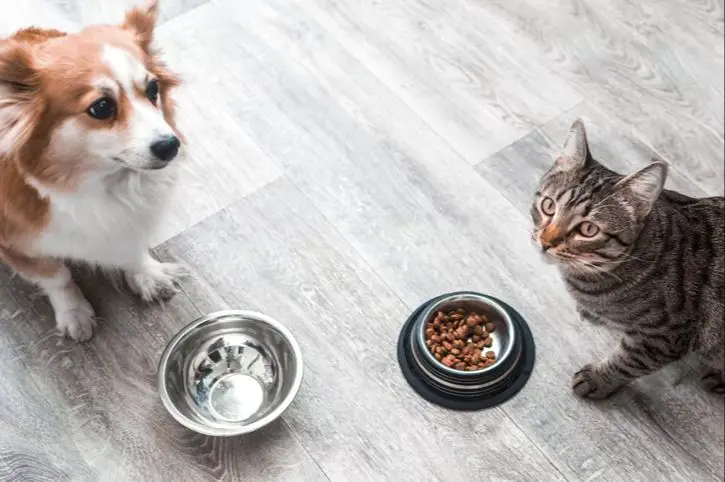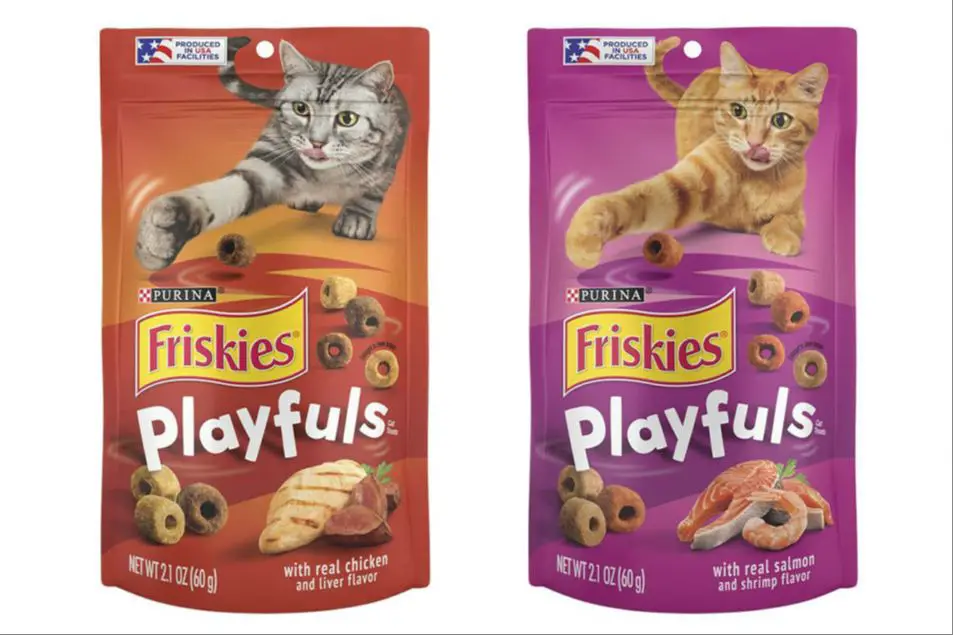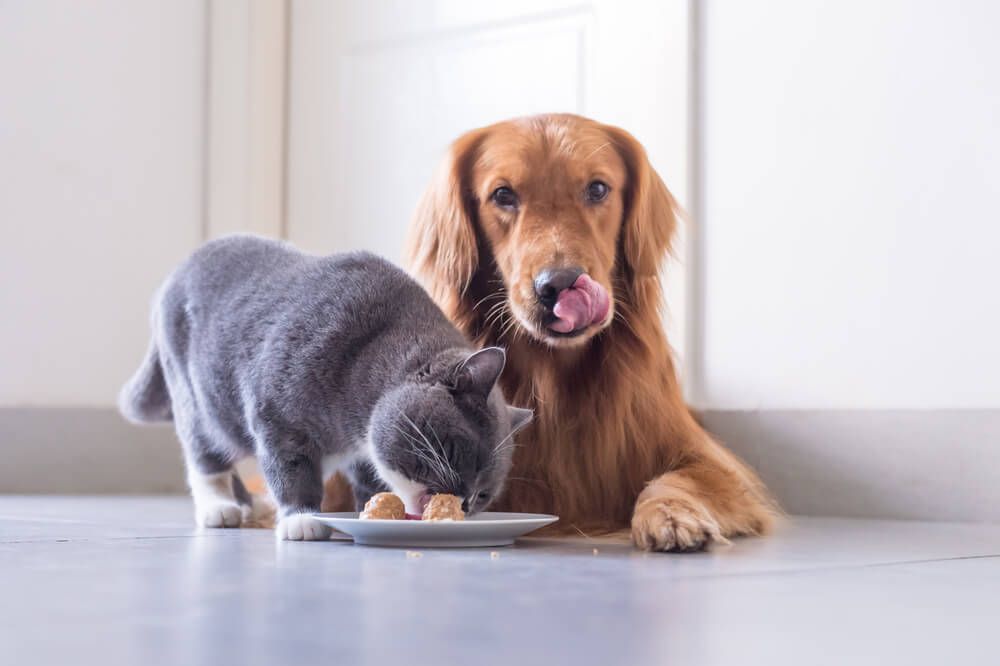For many pet owners, the question will arise at some point: can I feed my dog cat food? Cat food is formulated differently than dog food, so it’s natural to have concerns about potential adverse effects. While an occasional bite of kibble passed under the table won’t harm otherwise healthy dogs, there are some important considerations before making cat food a regular part of your dog’s diet. In this article, we’ll explore the nutritional differences between cat and dog foods and look at the risks and precautions for dogs who eat cat food. Understanding these key factors will help owners make an informed decision about mixing feline and canine diets.
Is It Safe?
Feeding cat food to dogs on occasion likely won’t cause any serious issues. However, there are some potential health risks to be aware of if dogs eat cat food regularly or in large quantities (Chefd, 2023).
The two main concerns are:
– Pancreatitis – Cat food tends to be much higher in fat and protein compared to dog food. The rich nutrition can inflame the pancreas and lead to pancreatitis in dogs, which causes vomiting, diarrhea, abdominal pain, and lack of appetite (Chefd, 2023).
– Nutrient Deficiencies – Dog food contains specific vitamins and minerals formulated for a dog’s nutritional needs. Cat food may be lacking in certain nutrients dogs require to thrive (Vet All Pet, 2023).
While the occasional nibble likely won’t harm them, you don’t want your dog filling up on cat food. It’s best to stick to dog food formulated for their unique nutritional requirements. Monitor for any signs of stomach upset or illness if they consume cat food, and contact your vet with any concerns (CatBandit, 2023).
Nutritional Differences

Dogs and cats have different nutritional requirements. According to a research paper published in the journal Reproduction Nutrition Development, dogs are omnivores while cats are obligate carnivores, meaning they require certain nutrients found primarily in animal sources (Legrand-Defretin 1994).
Cats require higher levels of protein, arachidonic acid, arginine, taurine and preformed vitamin A. They also need more dietary fat than dogs. Dogs can meet their nutritional needs with plant-based proteins and carbohydrates, while cats rely on the nutrients found in animal flesh. Feeding a cat dog food long-term can lead to vitamin and mineral deficiencies.
Ingredients
Friskies dry cat food contains ingredients that may be harmful to dogs if consumed in large quantities or over an extended period of time. According to Purina, Friskies Seafood Sensations contains fish, cereals, meat by-products, vegetable protein extracts, and added vitamins and minerals.

While the fish and cereals are generally safe for dogs, some of the other major ingredients are less ideal. Meat by-products consist of non-muscle meat parts like organs and bones, which dogs may have trouble digesting properly. Dogs also don’t require as much protein from vegetable sources as cats do. The vegetable protein extracts provide essential amino acids for cats but may be unnecessary fillers for dogs.
Over time, some additives like artificial colors and artificial preservatives can potentially cause health issues in dogs. Cats’ bodies process ingredients differently than dogs as well, so what is nutritionally appropriate for cats may not be best for dogs.
Portion Control
When feeding cat food to dogs, it’s important to pay close attention to portion sizes. Cat food is much more calorically dense than dog food. Feeding too much can quickly lead to weight gain or even obesity in dogs [Source 1].
As a general guideline, the daily caloric needs for an average adult dog range from 30-40 calories per pound of body weight. For a 30 lb dog, that’s about 900-1200 calories per day [Source 2]. Cat foods contain about 300-400 calories per cup. So a 30 lb dog should only eat around 1/3 to 1/2 cup of cat food per day.
It’s best to start with smaller portions (1/4 cup) and monitor your dog’s body condition. Adjust up or down as needed. Feeding dog-sized portions of cat food can double or triple your dog’s calorie intake, leading to rapid weight gain.
Short Term vs Long Term
Whether or not dogs can eat cat food depends on if it is a one-time occurrence or an ongoing habit. Eating cat food just once or for a few days likely won’t cause major health issues for an otherwise healthy dog. However, the nutritional imbalance becomes a real concern over time.
According to PetMD, eating cat food now and then probably won’t hurt dogs as long as the rest of their diet is nutritionally complete [1]. But Purina cautions that eating primarily cat food long-term denies dogs key nutrients they need for health like adequate protein, fat, vitamins, and minerals [2]. MasterClass notes that vitamin and mineral deficiencies, weight gain, kidney and liver problems may happen over time on a cat food diet [3].

The bottom line is cat food lacks the complete nutritional profile dogs need. Occasional cat food meals are probably fine, but making it a habit is risky.
Signs of Trouble
There are several signs to look out for if your dog eats cat food, especially in large quantities or over an extended period of time:
Vomiting – One of the most common signs is vomiting, as the dog’s stomach has difficulty digesting the higher protein and fat content in cat food (source).
Diarrhea – Cat food can also cause loose stools or diarrhea in dogs as it passes through the digestive tract (source).
Lethargy – The digestive upset can leave some dogs feeling lethargic and weak. They may seem more tired than usual.
Dehydration – Vomiting and diarrhea can lead to dehydration, so it’s important to keep an eye on your dog’s water intake.
Loss of appetite – Your dog may go off their food for a day or two if they don’t feel well after eating cat food.
Weight loss – In some cases, longer-term cat food consumption can cause weight loss in dogs since it lacks the right nutritional balance.
Kidney problems – The high protein levels in cat food may put extra strain on your dog’s kidneys over time (source). Look for increased thirst and urination.
Keep a close eye on your dog if they’ve eaten more than just a bite or two of cat food. Contact your vet if you have any concerns about dehydration, kidney issues, or other persistent symptoms.
Safer Alternatives For Dogs
While dogs can eat cat food on occasion, it should be avoided in the long term. There are safer alternatives that provide the proper nutrition for canines.
Dog owners should choose a high-quality dog-specific food that is balanced for their nutritional needs. Look for foods labeled complete and balanced with serving sizes for dogs.
Some better options include:
- Dry or wet dog food formulas
- Fresh, refrigerated dog foods
- Freeze-dried or dehydrated raw dog food
- Homemade cooked food for dogs with balanced recipes
Consult your veterinarian for brand and formula recommendations based on your dog’s age, size, and health status. They can help choose a nutritionally appropriate dog food to keep your canine healthy.
Precautions
There are several precautions pet owners can take to prevent dogs from eating cat food:

Feed cats and dogs in separate areas. Place the cat food bowls up high where dogs can’t reach or in a room that dogs don’t have access to. Cats usually prefer to eat in quiet, private areas anyway.
Consider feeding cats multiple small meals throughout the day using an automatic feeder rather than leaving food out at all times. This limits access for dogs.
Shop for cat food formulas with smaller kibble that may be less tempting for dogs. Cats generally prefer smaller bites they can eat multiple times throughout the day.
Use treat-dispensing toys or puzzle feeders for cats to make it more challenging for dogs to access the food. These provide mental stimulation for cats as well.
Train dogs a solid “leave it” command to discourage scavenging behavior. Praise and reward them for obeying.
Keep dogs well fed on an appropriate diet so they are less likely to seek out the cat food. Feed them on a consistent schedule.
Store cat food in a cabinet or container with a lock to keep dogs out when unsupervised. This adds a physical barrier for safety.
Supervise mealtimes and interactions between cats and dogs closely. Redirect or separate them if issues arise.
Conclusion
In summary, while an occasional nibble of your cat’s kibble won’t harm your dog, no product designed for a cat’s nutritional requirements is appropriate or completely safe for long-term feeding of a dog. Friskies cat food lacks certain proteins and nutrients your dog needs, is too high in carbohydrates, and contains flavorings and preservatives meant for feline tastes, not canine health. While you may see no ill effects from sharing a snack here and there with your furry friends, you should never make a habit of routinely feeding your dog cat kibble instead of food formulated specifically for dogs.
The bottom line: it’s far better and safer to stick with foods designed for your dog’s nutritional needs. Talk to your veterinarian for recommendations on the highest-quality, healthiest dog foods for your four-legged best friend.

